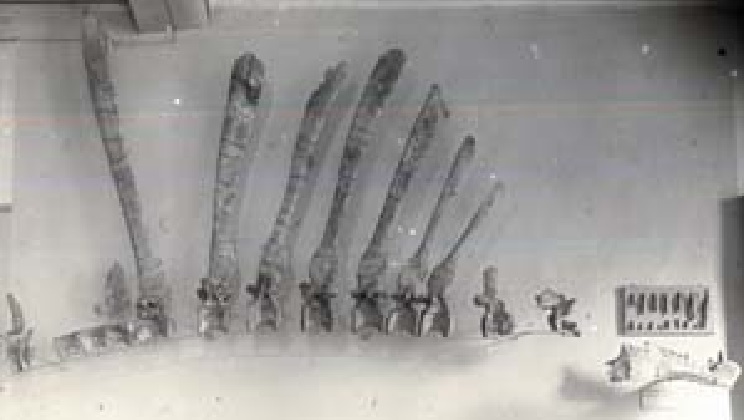
This is the only photographic proof of German researcher Ernst Stromer’s discovery of Spinosaurus. Image from the Washington University in St. Louis
The Spinosauridae is a specialized group of large tetanuran theropods known from the Berriasian to the Cenomanian of Africa, South America, Europe and Asia. The group is characterised by a long, narrow skull, robust forelimbs with a hooked thumb claw, and tall neural spines forming a dorsal sail. Spinosauridae has been divided in two clades Baryonychinae (including Suchomimus, Baryonyx and Cristatosaur), and Spinosaurinae. Baryonyx walkeri, described by Alan Charig and Angela Milner in 1983, is the oldest unquestionable spinosaurid. The ecology of the group has been debated since the original discovery of Spinosaurus aegyptiacus in 1911. Although Stromer’s original description of Spinosaurus was published in 1915, a more complete detailed picture of its anatomy, evolution, and biogeography only begun to emerge in recent decades with the discovery of a partial skeleton of a subadult individual of S. aegyptiacus in the Cretaceous Kem Kem beds of south-eastern Morocco. At the time of deposition, this part of Morocco was located on the southern margin of the Tethys Ocean and it was characterized by an extensive fluvial plain dominated by northward flowing rivers and terminating in broad deltaic systems on Tethys’ southern shores. The discovery of this new skeleton of Spinosaurus has challenged the paradigma about the restriction of non-avian dinosaurs to terrestrial environments. Previous paleo-histological studies suggested that Spinosauridae had a strong relationship with aquatic environment. Now, a new study published in Nature, indicates that they were aquatic specialists.

Osteohistology variation among the analysed spinosaurid taxa. From Fabbri et al., 2022
Since the works of Nopcsa and Heidsieck in 1934, it has been suggested that the secondary adaptation of tetrapods to an aquatic environment induced modifications of the inner architecture and histological characteristics of bones. Using femora and dorsal ribs to test the correlations between bone density and ecology of these animals, the team lead by Dr. Matteo Fabbri built a dataset of 291extinct and extant amniote species, including mammals, marine reptiles and birds.
Bone density is associated with buoyancy control. Many studies on avian microanatomy had already established a relationship between high bone compactness (i.e., considerable degree of osteosclerosis) and diving behavior. The presence of high bone density in Spinosaurus and Baryonyx supports the hypothesis that spinosaurids were aquatic specialists. Additionally, the highly specialized morphology of the Spinosaurus tail allowed it to function as a propulsive structure for aquatic locomotion. The anterior positioning of the center of mass within the ribcage may have also enhanced balance during aquatic movement. On the other hand, Suchomimus exhibits hollower bones and it was more adapted to a life hunting in shallow water.
References:
Fabbri, M., Navalón, G., Benson, R.B.J. et al. Subaqueous foraging among carnivorous dinosaurs. Nature (2022). https://doi.org/10.1038/s41586-022-04528-0
HONE, D. W. E. and HOLTZ, T. R. (2017), A Century of Spinosaurs – A Review and Revision of the Spinosauridae with Comments on Their Ecology. Acta Geologica Sinica, 91: 1120–1132. doi: 10.1111/1755-6724.13328
Ibrahim, N., Sereno, P. C., Dal Sasso, C., Maganuco, S., Fabbri, M., Martill, D. M., Zouhri, S., Myhrvold, N., Iurino, D. A. (2014). Semiaquatic adaptations in a giant predatory dinosaur. Science, 345(6204), 1613–1616. doi:10.1126/science.1258750
Aureliano, T., Ghilardi, A.M., Buck, P.V., Fabbri, M., Samathi, A., Delcourt, R., Fernandes, M.A., Sander, M., Semi-aquatic adaptations in a spinosaur from the Lower Cretaceous of Brazil, Cretaceous Research (2018), doi: 10.1016/j.cretres.2018.04.024




